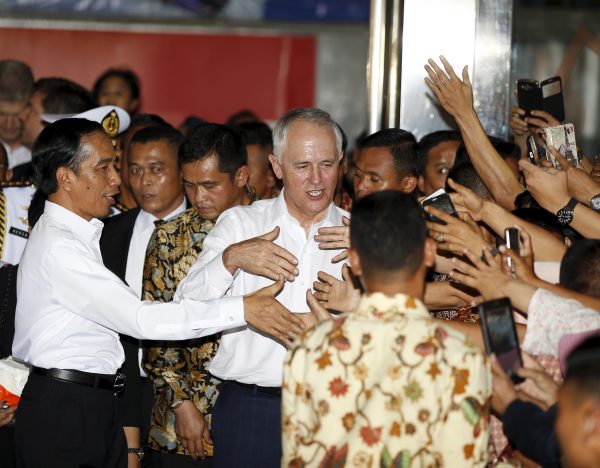Pundits tend to overlook the fact that, when aggregated, Southeast Asian countries that are members of ASEAN are Australia’s second largest trading partner, after China. With a population of 620 million and a combined GDP approaching $US2.5 trillion, the region has become an increasingly important partner for Australian trade and investment. In 2014 alone, Australia’s total trade with ASEAN countries was more than $US120 billion — which is more than Australia’s trade with Japan, the EU or the United States.
Australia’s trade, tourism, cultural and educational ties with ASEAN countries have grown dramatically since the organisation was founded in 1967. Yet Australians often skip over Southeast Asia, literally and metaphorically, when engaging on ‘regional’ security and economic matters.
Australia’s economic and security interests are inextricably linked to its ASEAN neighbours. This is reflected by the growth in free trade agreements (FTAs) including the ASEAN–Australia–New Zealand FTA, which came into force in January 2010 and is complemented by bilateral agreements with Malaysia, Singapore and Thailand. People-to-people links are growing as well, thanks to strong educational ties, two-way tourist traffic and migration.
The 2011 census listed over 650,000 people in Australia of Southeast Asian heritage. Australia’s Department of Foreign Affairs and Trade recorded over one million ASEAN visitors to Australia in 2014 and over 100,000 students from ASEAN countries enrolled to study in Australia. Yet few Australian-born students are invested in Southeast Asia, learning its languages or understanding its cultures.
Despite its apparent inattentiveness, Australia is more entwined with Southeast Asia than ever before. Foreign, trade and defence ministers engage with their counterparts in the ASEAN Regional Forum, the East Asia Summit and the ASEAN Defence Ministers Meeting Plus. There are senior officials’ meetings and other bilateral meetings on the sidelines of these and other forums like APEC, the Shangri-La Dialogue and the Asia–Europe Meetings.
These ties are important, but there are limits to their utility. ASEAN operates on a consensus basis and struggles to speak with one voice. While it is in Australia’s interests to pursue this relationship, this must be done with a clear understanding of the limits of ASEAN’s power and reach. China effectively has prevented ASEAN from speaking with one voice on anything remotely controversial concerning the South China Sea because it insists on dealing with such issues bilaterally. This negates the potential strength of an ASEAN consensus that could undermine China’s interests.
When considering the countries within ASEAN, Indonesia looms large. Totalling over 250 million people spread over more than 17,000 islands, Indonesia is the world’s third largest democracy with the world’s largest Muslim population. Indonesia has also felt uneasy about the Western transplant to its south. That unease has never actually manifested into identifying Australia as a threat. Yet the relationship has certainly been contentious, with vicissitudes for more than half a century, most notably over the East Timor intervention in 1999.
Australia mended fences following terrorist attacks in Bali and Jakarta and after the Boxing Day Tsunami. But the relationship has been on-again, off-again since then, thanks to Australia’s poor handling of a range of issues. This includes Australia’s sudden cessation of live cattle exports to Indonesia, Australia stopping boats of people seeking unregulated entry into Australia, the Snowden eavesdropping revelations and Indonesia’s unwillingness to offer clemency to Australians on death row.
Australia’s security is inextricably linked to the security and stability of Indonesia. Indonesia has a key role to play in the South China Sea as the largest and most significant nation in ASEAN — with its Exclusive Economic Zone also under challenge by China’s claims. But even with the two countries’ extensive shared history and concerns about the security and stability of the region the bilateral relationship remains fragile.
Prime Minister Malcolm Turnbull has sought to creatively and respectfully engage with Indonesia, as it is of fundamental importance to Australia. It is crucial that more effective methods to minimise the turbulence in the bilateral relationship are found.
In May 2015 Australia and Singapore made a joint announcement of an ‘Australia–Singapore Comprehensive Strategic Partnership’. These ties are akin to the Closer Economic Relations FTA and intimate security ties between Australia and New Zealand. This makes sense — in an ever-more connected world, what happens in and around the waters of Southeast Asia is of material consequence to Australia’s security and prosperity.
New multilateral ties between Malaysia, Australia, New Zealand, Indonesia and Singapore could significantly contribute to warming the regional dynamics beyond the limitations of bilateral links. So Australia must think big — not just about China — but its own immediate neighbours in ASEAN and Southeast Asia. This requires leadership, determination and vision.
John Blaxland is Professor of International Security and Intelligence Studies and Acting Head of the Strategic and Defence Studies Centre, The Australian National University.

